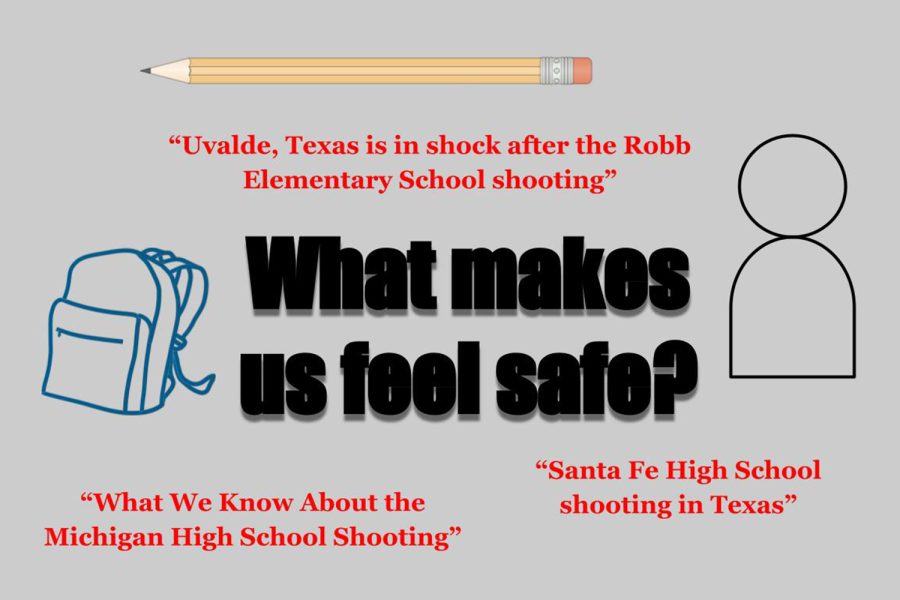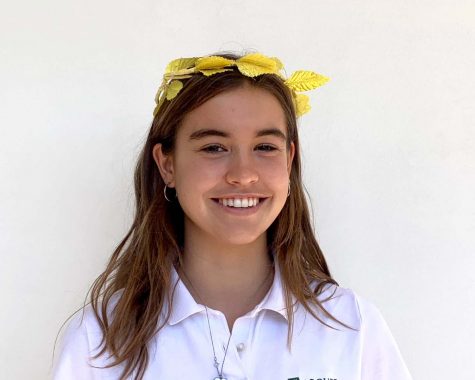Editorial: What makes us feel safe?
Photo credit: Greta Irvine
News headlines of three school shootings, including the mass shooting last week at Robb Elementary school. In a nation frequently grieving from school shootings, is time we, the students, answer one question: What makes us feel safe?
May 31, 2022
What makes us feel safe?
Students across the nation have had to reckon with this question following the tragic mass shooting at Robb Elementary School in Uvalde, Texas this past week.
And, honestly, we have had to reckon with this question our whole lives. School shooting after school shooting. What has changed since Columbine?
Following the Tuesday massacre, politicians and policymakers revitalized the debate on school safety; do we “harden” schools or “soften” them. The increasingly common suggestion of “hardening” schools by Republican politicians looks to arm teachers and administrators and limit entry points to school buildings. “Softening” schools, on the other hand, is an approach to combating gun violence that focuses on supporting the social and emotional needs of students.
As students, it is time we answer the question, What makes us feel safe? We are the ones walking the halls. We are the ones routinely practicing active shooter drills. It is our lives at stake, after all.
More guns do not make us feel safe.
Armed teachers do not make us feel safe.
Walled-up schools with several armed police officers do not make us feel safe.
Armed educators — those we learn from, look up to and share classroom space with every day, whose lives are devoted to education, not armed combat — cannot possibly be the solution to school shootings. The heartbreaking words of 17-year-old Mia Tretta who was wounded in the shooting at Saugus High School say it best:
“Teachers are not there to be war heroes,” Tretta said. “It took 8 seconds. No one can stop a shooter in 8 seconds.”
The statistics demonstrate police officers are no solution either; According to The Washington Post, its analysis of “225 school shootings between 1999 and 2018 found that 40% of the affected campuses had a police officer, meaning the mere presence of an officer was not enough to deter the shooter.”
Looking solely at mass shootings this past month would lead you to the same conclusion; there were security guards at the supermarket in Buffalo and police and security at Robb Elementary School.
But even if they did consistently deter shooters, the presence of police officers or security guards on campus creates a new array of issues. Armed school officers have, in the past, harmed and even killed young people. This problem paired with the clear racial disparities of school policing makes increasing armed officers and security guards on school campuses an unacceptable, dangerous solution. How can students feel safe when those there to protect them pose a great danger themselves?
So, faced with a seemingly unsolvable issue, what should we do? What would make us feel safe?
Ron Avi Astor at the University of Southern California proposed a thoughtful approach to NPR: the public health approach.
“A public health approach to disease means, instead of waiting for people to be rushed to emergency rooms with heart attacks or the flu, you go into the community…[For school shootings,] instead of waiting for people to, again, be rushed into emergency rooms, you go into the community with preventive resources,” Astor said. “You do your best to lower the background levels of bullying and discrimination.”
Preventative resources can look like providing students with more mental health resources and guidance counselors; students must have access to resources that educate them on how to handle problems and emotional or mental health crises to deter them from taking extreme measures.
Realistically, we can’t expect all students with emotional or mental health crises to utilize such resources. That is why mental health conversations must be mandatory in schools. When we speak about mental health, we destigmatize the topic, empowering students to feel heard, speak up and take action when they see alarming signs among their peers.
With the increased usage of social media prior to mass killings, media literacy is a conversation we must not forget about. As stated in the article, “Shooter warning signs get lost in sea of social media posts… Increasingly, young men have taken to Instagram, which boasts a thriving gun community, to drop small hints of what’s to come with photos of their own weapons just days or weeks before executing a mass killing.”
Salvador Ramos posted a picture of two AR-style semi-automatic rifles just days before killing 21 people at Robb Elementary School.
Ethan Crumbley posted a photo of a semi-automatic handgun captioned, “Just got my new beauty today,” days before killing four students at his high school in Michigan in 2021.
The list goes on.
Our generation of social media users needs to know how to navigate these platforms. Students must be aware of what posts and signs may look like and understand the necessity of reporting them, whether that be to a school counselor or the police. Law enforcement and social media companies cannot, among millions of posts, spot every gun post from a potential mass shooter.
We must acknowledge that this problem is so much more than mental health. All countries in the world have mental health issues but none with school shootings as frequent as ours.
The “softening” of schools must be paired with gun control, an aspect of the solution Astor did not overlook.
“And, these experts say, you remove the major ‘environmental hazard’ that contributes to gun violence: the guns,” Astor said. “The eight-point plan calls for universal background checks, a ban on assault-style weapons, and …a type of emergency order that would allow police to seize a gun when there is an imminent threat.”
There is no easy answer. There is no immediate anecdote. Kids are dying. And if we don’t take effective action that limits guns, not adds them, that focuses on preventing, not simply responding, we will continue to experience agonizing loss as a nation as we did last Tuesday when 19 children and two teachers lost their lives to gun violence.










